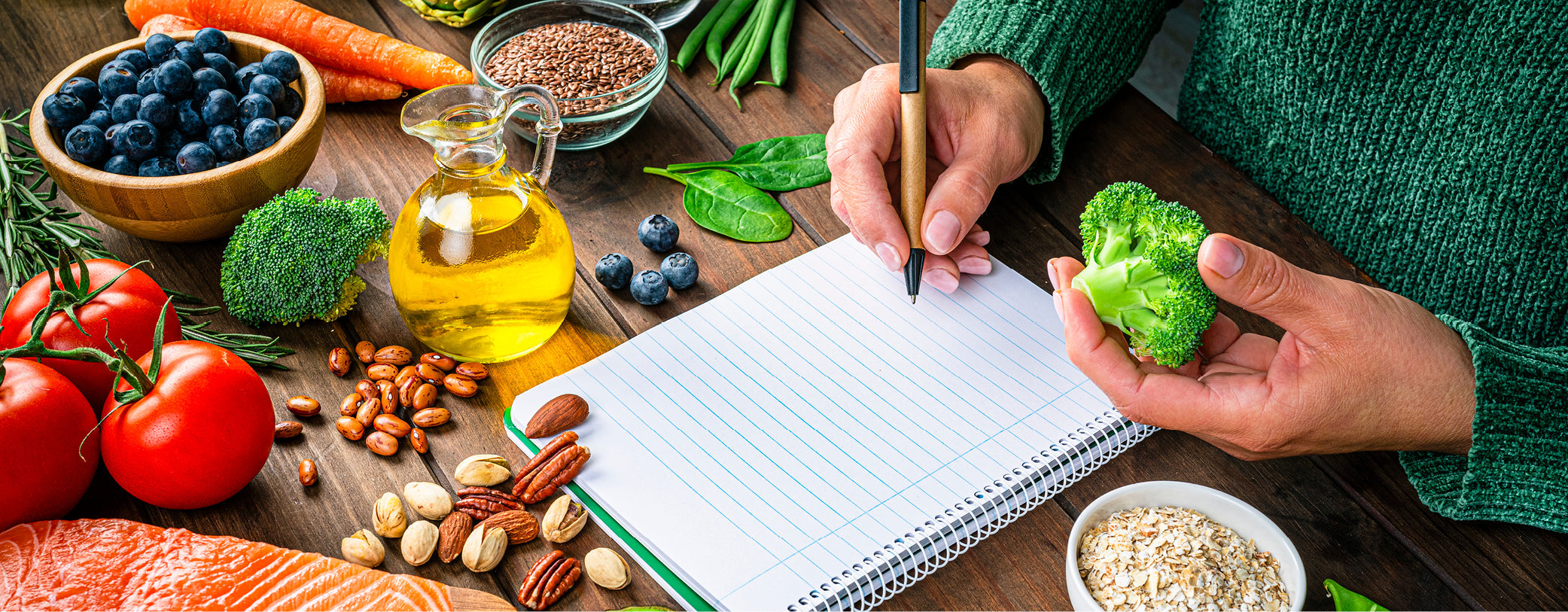Everything was fine in the evening – but in the middle of the night, you suddenly wake up with a start: Your big toe or another joint is terribly painful, red, and perhaps even swollen. "Oh dear, a gout attack ," you might sigh.
How often flare-ups occur also depends on your diet . Here, you'll learn which diet is good for you if you have gout and why you don't have to worry about completely abstaining. We'll also provide you with a printable food chart: for a symptom-free life .
What is gout and how does it develop?
Gout is a metabolic disease associated with elevated uric acid levels in the blood ("hyperuricemia"). If left untreated, uric acid crystals ("urates") accumulate in the joints and trigger painful inflammation . Tendons and internal organs—especially the kidneys—can also be affected.
Because gout is associated with a lavish lifestyle , it has long been considered a disease of royalty and wealth. Indeed, diet plays a crucial role – some foods increase uric acid levels , while others have no effect or even reduce them.
Nevertheless, the actual cause lies elsewhere. Due to genetics or illness, the body either produces too much uric acid – or it excretes too little in the urine. A rich diet alone therefore does not trigger gout. However, with a predisposition to gout, the attack is often preceded by a large meal .
Preventing gout attacks: The 5 most important principles
Some sufferers stumble from one attack to the next, while others experience long periods of pain-free relief. What you eat determines how frequently your attacks occur. The following five principles can help prevent outbreaks and prevent long-term damage.
1. Prefer low-purine foods
Purines are found in every cell as a building block of genetic material. They participate in the formation of enzymes and energy metabolism —they are vital substances found in almost all foods. Purines are also produced by our bodies.
The problem: During cell renewal or digestion, the body breaks down these purines—a process that produces uric acid . Therefore, a diet rich in purines can increase your uric acid levels by 1-2 mg/dl.
If the value exceeds 6 mg/dl (in women) or 7 mg/dl (in men), hyperuricemia is present. Meat and fish, in particular, contain high levels of purine—so much so that each additional portion of meat increases your risk of gout by 21%. (1)
2. Enjoy fat in moderation
The breakdown of fat produces metabolic products that negatively impact the excretion of uric acid . (4) Therefore, try not to consume more than 30% of your daily energy needs from fat—that's about 600 calories, or five tablespoons of oil, for example. Otherwise, this can encourage a relapse of gout.
3. Reduce your alcohol consumption
Alcohol increases uric acid production and simultaneously inhibits its excretion. It also increases appetite for fatty foods.
The combination of alcohol and rich, hearty foods is especially likely to trigger the next attack. Therefore, try to reduce your consumption as much as possible – this is especially true for beer , as brewer's yeast is one of the foods richest in purines.
4. Avoid fructose
Fructose stimulates the body's purine production and inhibits the excretion of uric acid . (2) However, this applies primarily to beverages sweetened with fructose, such as corn syrup—fresh fruit can still be consumed. According to recent findings, fruit juice may also be safe . (3) Therefore, you can rest assured that you only consume small amounts of fruit juice concentrates .
5. Aim for your normal weight
The risk of gout increases with a body mass index of over 25. (5) If you lose excess weight, the likelihood of a recurrence decreases. This is because as the weight melts away, uric acid levels also decrease. Furthermore, kidney function may improve. (6)
But beware: Crash diets and fasting regimes put your metabolism into ketosis. If your body is deprived of carbohydrates for an extended period, it must obtain energy from fats and proteins. This can simultaneously decrease urine output . (7)
This means that radical starvation provokes exactly what you're trying to prevent: the next attack. Therefore, lose weight slowly – a maximum of 2-3 kilos per month is optimal.
What does a low-purine diet look like?

A diet high in purines causes uric acid levels to skyrocket, while a diet low in purines lowers them—that's the theory. But what can gout patients eat, and what should they avoid? In short: absolutely nothing. It's not about completely eliminating certain foods—it's about enjoying them in moderation.
Experts recommend a maximum of 500 milligrams of purines per day . During and after a gout attack, you should temporarily consume only 200 milligrams. (8) If you have these numbers in mind, you can create your diet based on the purine content of your favorite foods.
Below you'll find a detailed gout nutrition table with the purine content of various foods. You can also download it as a PDF and print it out to hang in your kitchen if needed. Important: These are only approximate figures. The purine content varies depending on the preparation method – for example, some of the purine is leached into the water during cooking.
Our "Prohibited List for Gout" >>Download Table<
-
Low-fat dairy products: A study of 10 subjects revealed that casein significantly reduced uric acid concentration. (9)
-
Coffee: The effect was strongest with regular coffee, but decaffeinated coffee also had a positive effect. Tea, on the other hand, appears to have no effect. (10)
-
Cherries: Various scientific studies conclude that cherries—unlike other fruits—reduce the risk of gout attacks. (11)
DASH diet: Modern approach to gout nutrition therapy
If you don't feel like counting purines, the DASH diet is an excellent option for people with gout. It's based on the Mediterranean diet and was originally developed to treat high blood pressure . However, studies show that it also lowers uric acid levels . (12)
The DASH diet prioritizes natural and plant-based foods . The menu focuses on:
- Whole grain products: 7 to 8 portions spread throughout the day, for example whole grain bread, pasta or rice.
- Vegetables: At least 3 servings daily. Feel free to try varieties like spinach, asparagus, salsify, or mushrooms, which are normally considered high in purines. According to recent studies, plant-based purines do not appear to have any effect on uric acid levels. (13)
- Fruit: At least two servings daily. Here, too, there are no restrictions on the variety. It should be fresh only – enjoy candied dried fruit or sugared preserves only as a sweet treat.
- Nuts, seeds and legumes: 4 to 5 servings per week.
- Lean meat and fish: 1 to 2 portions per week, for example salmon or chicken breast.
You should largely avoid processed, red, and fatty meats, fast food, sweets, convenience foods, and salty snacks. Furthermore, food preparation plays an important role: Add flavor to meals with herbs, if possible, and use salt sparingly.
Conclusion: With the right diet plan you can finally live pain-free again
Even if it seems complicated at first, it's worth it to prevent further gout attacks with the right diet – otherwise, you risk long-term damage. This article has shown you that some foods are more advisable than others:

FAQ - Frequently Asked Questions
What should you not eat if you have gout?
Some foods should be strictly limited if you have gout, as they can increase uric acid levels in the body. These include:
- Alcohol: Especially beer and spirits.
- Fatty foods: Fried foods, fatty meat or sausage.
- Fructose-containing products: Sugary drinks such as soft drinks and sweetened fruit juices.
- Prefer a low-purine diet: Avoid foods that are very high in purines, such as offal (liver, kidney), anchovies, herring, and other fish with high purine content.
These foods can trigger or worsen gout attacks and should only be consumed in moderation.
Which foods do not contain purines?
Foods with no or very low purine content are ideal for gout patients. These include:
- Dairy products: Low-fat milk, yogurt, cheese (e.g. cream cheese or cottage cheese).
- Eggs: Excellent source of protein without purines.
-
Vegetables:
- cucumbers
- Carrots
- Kohlrabi
- paprika
- Salads
- pumpkin
These foods support a low-purine diet and can be consumed without concern.
Which vegetables are suitable for gout?
Can you eat cheese if you have gout?
Yes, cheese is almost purine-free and therefore well-tolerated. Recommended varieties include:
- Edam
- Emmental cheese
- Gouda
- Mozzarella
- cottage cheese
- cream cheese
However, be mindful of the fat content. Choose varieties with up to 45% fat by dry matter, and limit your consumption to a maximum of three servings of dairy products per day. A diet too high in fat can promote obesity, which in turn increases the risk of gout.
Which meat can you eat if you have gout?
Lean meat is allowed in moderation, especially:
- Poultry such as turkey or chicken (without skin).
- Lean beef or venison.
Remove the skin and favor low-fat cooking methods such as boiling or steaming to minimize purine content. Avoid offal and highly processed meat products such as sausage or bacon.
What bread can you eat if you have gout?
Can I eat pizza if I have gout?
Which beer can you drink if you have gout?
Which drinks are forbidden if you have gout?
The following drinks should be avoided if you have gout:
- Alcoholic beverages (especially beer and spirits).
- Soft drinks and sweetened drinks.
- Cocoa or other sugary hot drinks.
Allowed alternatives:
- Water (preferably 2-3 liters daily).
- Unsweetened herbal or fruit teas.
- Vegetable juices and acidic fruit juices (in moderation).
- Coffee and milk, as they can even lower uric acid levels.




















Leave a comment
This site is protected by hCaptcha and the hCaptcha Privacy Policy and Terms of Service apply.